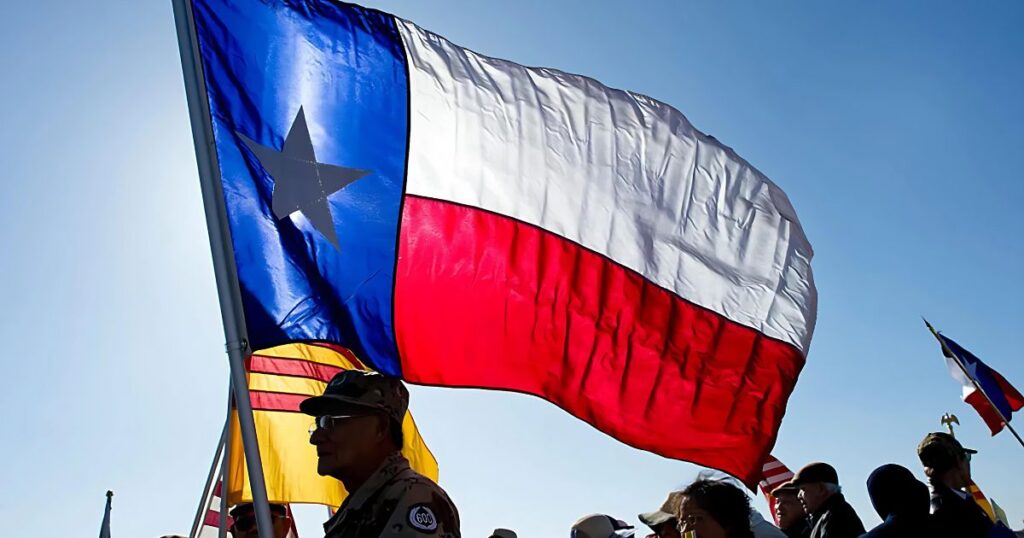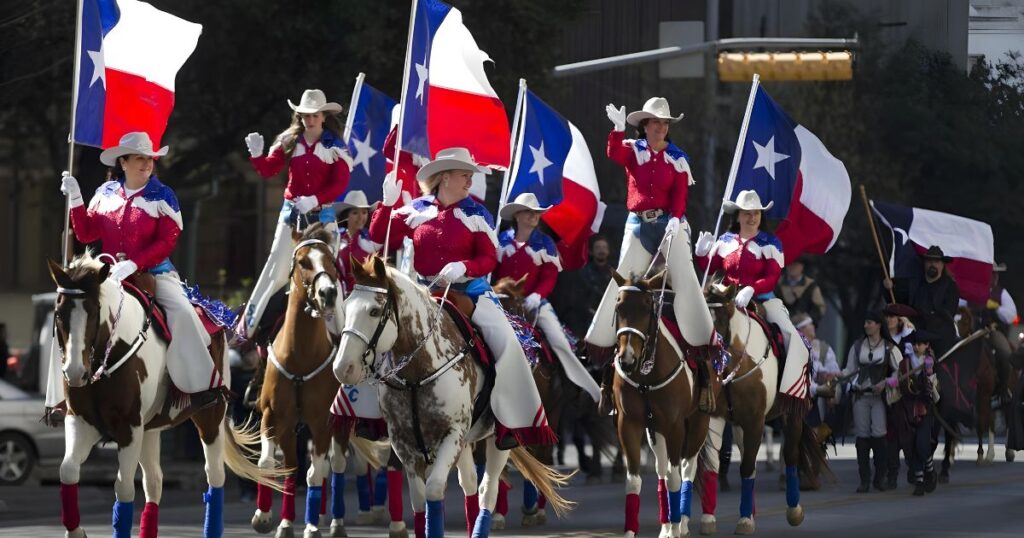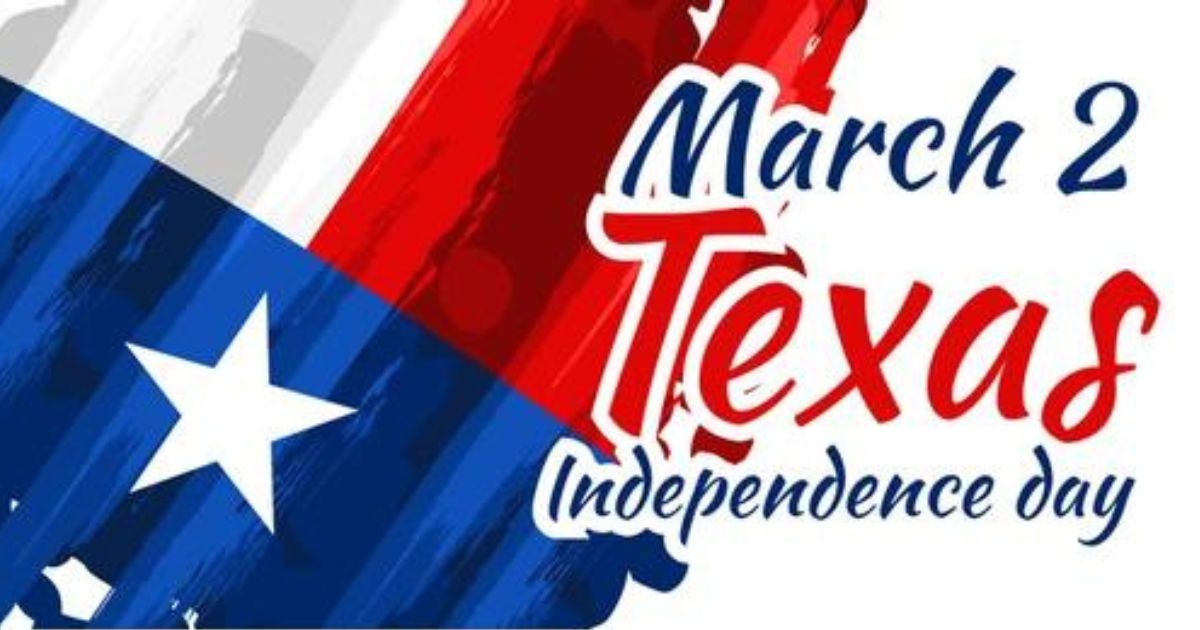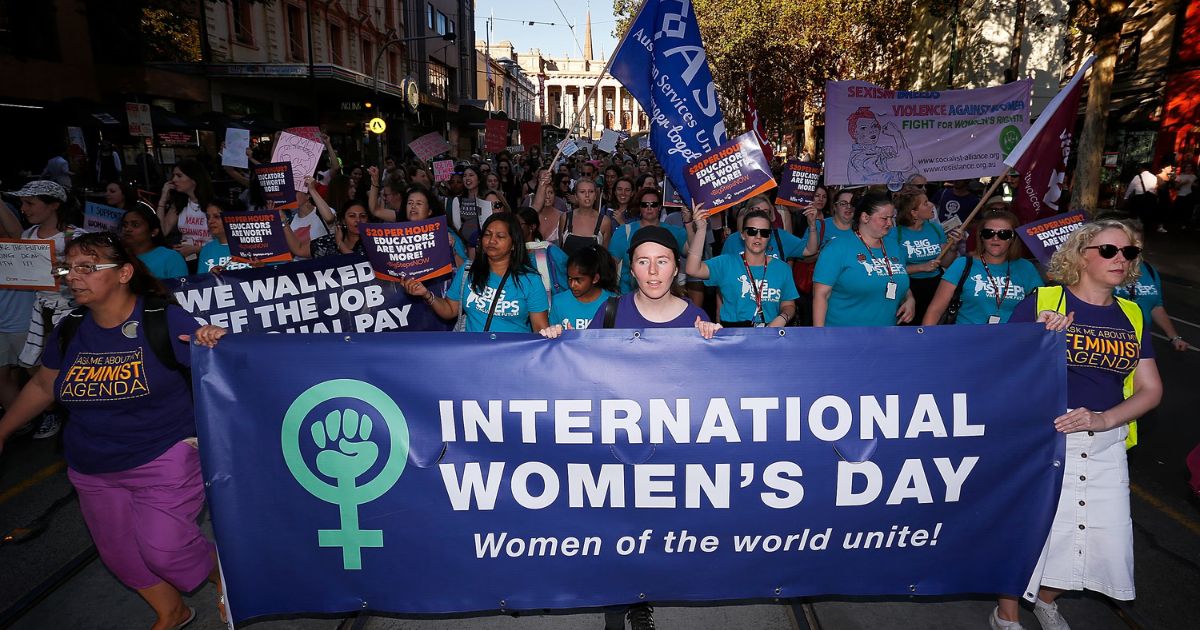Texas Independence Day 2024
Texas Independence Day is an annual state holiday commemorating the adoption of the Texas Declaration of Independence on March 2, 1836. This year, 2024, marks the 188th anniversary of this significant date in Texas history. Here is some background information and details about the celebrations and events for Texas Independence Day 2024.
Read More: Digital News Planet
History of Texas Independence
The history of Texas gaining independence from Mexico and becoming its republic began in the 1820s. At this time, Texas was part of Mexico under Spanish rule. In 1821, Mexico won its freedom from Spanish rule. To help populate the large territory of Texas, Mexico offered cheap land grants to American settlers if they agreed to become Mexican citizens and follow Mexican law. Many Americans accepted this offer and moved to Texas in the 1820s and 1830s.
Key factors leading to the Texas Revolution:
- Cultural clashes – The American settlers in Texas were predominantly Protestant English speakers, while Mexico was primarily Catholic and Spanish speaking. This caused cultural conflicts.
- State’s rights – The Texian settlers felt the Mexican government was overreaching and violating the rights granted to them when they had received land.
- Slavery – Slavery was outlawed in Mexico in 1829, but it persisted in Texas. Texians strongly supported keeping slavery legal.
- Santa Anna – Mexican president Antonio Lopez de Santa Anna was viewed as a dictator who had overthrown the Mexican Constitution of 1824.
By 1835, tensions had escalated between Mexican authorities and the Texian settlers. In October 1835, settlers attacked a Mexican garrison near Gonzales, officially starting the Texas Revolution.

Key events of the Texas Revolution:
The Battle of Gonzales – This minor skirmish on October 2, 1835, is considered the first battle of the Texas Revolution. Mexican troops had arrived in Gonzales to retrieve a cannon that had been given to the town for defense against Native American raids. The Texians refused to hand over the cannon, raising a flag that defiantly read “Come and Take It.” In the ensuing skirmish, the Mexicans failed to retrieve the cannon. Though a very minor clash, it marked increased tensions and the start of armed conflict between Texian settlers and Mexican authorities.
The Siege of Bexar
In the Fall of 1835, Texian forces moved to seize San Antonio de Bexar, lightly defended by Mexican troops. Texians took over the city on December 10, 1835, after several days of fighting and a siege. Victory at San Antonio was a strategic win and provided a base of operations. Texian commander Benjamin Milam was killed in the battle. By controlling San Antonio, Texian forces could cut off potential Mexican advances deeper into Texas territory.
The Alamo
The most famous battle site is the Alamo in San Antonio. About 200 Texian rebels occupied the Alamo in January 1836 when they heard of the advancing Mexican Army under General Santa Anna. Though vastly outnumbered, the Texian’s force held out for 13 days against a siege by Santa Anna’s troops. On March 6, 1836, the Mexicans attacked before dawn and overwhelmed the Alamo’s defenses after fierce hand-to-hand combat. All of the Texian defenders were killed, including famous frontiersmen like Jim Bowie and Davy Crockett. Their sacrifice created the legendary rallying cry, “Remember the Alamo!”
The Runaway Scrape
As the Mexican Army advanced after the Alamo, Texian settlers panicked and fled their homes in what became known as the Runaway Scrape. Thousands of civilians packed up belongings and retreated towards the U.S. border to escape Santa Anna’s troops. The exodus caused chaos, and many Texian settlers subsequently returned and rallied to defend their territory.
In the Battle of the Alamo, Texian forces lost this battle on March 6, 1836, after a 13-day siege. “Remember the Alamo!” became a rallying cry.
The Battle of San Jacinto – am Houston led the Texian Army to victory on April 21, 1836, near Houston. In an 18-minute battle, the Texians surprised a Mexican camp, shouting, “Remember the Alamo!” and “Remember Goliad!” as they attacked. Within minutes, the Texians had overwhelmed Santa Anna’s forces, killing and capturing hundreds of soldiers. Santa Anna was also arrested the next day, bringing an end to Mexico’s ability to continue fighting for control over Texas.
These significant battles between 1835 and 1836 led to Texas securing independence from Mexico. The Texian victory marked the end of hostilities with Mexico and the creation of the Republic of Texas.
On March 2, 1836, during the Texas Revolution, delegates from across Texas signed the Texas Declaration of Independence at Washington-on-the-Brazos. With this document, Texas formally declared independence from Mexico.
Two months later, in May 1836, Santa Anna surrendered and signed a treaty recognizing Texas’s independence. The Republic of Texas was created, and Sam Houston was elected its first president. On December 29, 1845, Texas was admitted to the United States as the 28th state.
Texas Independence Day Events in 2024
Various events are held across Texas yearly to commemorate and celebrate Texas Independence Day on March 2. Here are some of the major events scheduled for the state holiday in 2024:

The Texas Declaration of Independence Reenactment
This annual event organized by the Texas Parks and Wildlife Department takes place at Washington-on-the-Brazos State Historic Site. On March 2, 2024, at 9 AM, actors in period costumes will reenact the Texas Declaration of Independence signing. Visitors can observe the reenactment and explore the site to learn more about this historic moment.
Festival and Events in Austin
As the state capital, Austin hosts several Texas Independence Day events. The Bullock Texas State History Museum will have free admission on March 2, along with special programs and exhibits. The Austin Symphony Orchestra will perform a celebratory concert titled “Deep in the Heart of Texas” in the evening. Local music venues will host live performances during the day.
The Official Texas Independence Day Ceremony
Standing on the steps of Austin’s Texas State Capitol, an official state ceremony will start at 10 AM on March 2, 2024. It will include speeches by Texas lawmakers and state officials, a cannon firing, and a performance of the Texas National Anthem.

San Jacinto Festival & Battle Reenactment
Near Houston, the San Jacinto Battleground State Historic Site will have a multi-day festival leading up to March 2. There will be concerts, a carnival, food vendors, historical exhibits, and reenactments of the 1836 Battle of San Jacinto. On Texas Independence Day, participants in period costumes will reenact portions of the famous battle that led to Texas gaining independence from Mexico.
Six Flags Over Texas Theme Park Celebrations
On March 2, 2024, Six Flags Over Texas, an amusement park near Arlington, will commemorate with special festivities. Vocal performers will sing the Texas National Anthem throughout the day. There will be a fireworks show choreographed to Texas-themed music in the evening. Rides like the Texas Giant and Runaway Mountain will have commemorative themes.
Local Community Events
Many other local cities, towns, businesses, schools, churches, and community centers will host smaller-scale events to celebrate Texa’s history and independence. These may include concerts, food festivals, museum exhibits, children’s activities, dancing, and more.
How Texans Celebrate the State Holiday
Texas Independence Day is a source of immense state pride for Texans across the Lone Star State. Here are some of the common ways Texans celebrate the state holiday:
- Attend one of the parades, fairs, or community events
- Participate in the battle reenactments held at historic sites
- Visit a museum or historic site to learn about Texas history and independence
- Attend a rodeo, cowboy show, or cattle drive demonstration
- Host a Texas-themed party with traditional foods like chili, brisket, and pecan pie
- Decorate homes, businesses, and public spaces with Texas flags and banners
- Listen to Texas country and western music
- Dress in Western wear like cowboy boots and hats
- Fly the Texas flag prominently
- Read biographies on famous Texans like Sam Houston, Stephen F. Austin, and Davy Crockett
- Share family stories of Texas ancestors and past Texas Independence Days
- Post on social media using hashtags like #TexasIndependenceDay
- Watch fireworks shows and other televised Texas events & celebrations
- Say “Happy Texas Independence Day!” to friends, neighbors and strangers
No matter how citizens choose to celebrate, the day represents a commemoration of Texas’s liberty, history, and pride. After 188 years, the Lone Star State still recognizes Texas Independence Day as one of the most important holidays.

Texas Independence Day Traditions
Over nearly two centuries, Texans have continued traditions to mark Texas Independence Day. Here are some of the historical and modern traditions you may observe on March 2:
Reading the Texas Declaration of Independence
- Politicians, historians, or schoolchildren will read the Declaration signed in 1836 at official state events. Texans are encouraged to read it privately at home, too.
Raising the Texas Flag
- The blue Lone Star Flag is flown or raised across the state to commemorate independence. Homeowners will display it prominently.
Singing Songs of Texas Pride
- “Texas, Our Texas” is sung at events. Traditional songs include “Deep in the Heart of Texas” and “The Yellow Rose of Texas.”
Learning About Significant Figures
- Texans study biographies and tell tales about critical figures like Sam Houston, Stephen F. Austin, and those who fought at the Alamo.
Enjoying a Texas-Style Meal
- Traditional foods include brisket, ribs, chili, chicken fried steak, queso, and pecan pie.
Adding Bluebonnets to Decor
- Texas’ official state flower, the bluebonnet, is incorporated into Independence Day decorations and clothing.
Participating in War Reenactments
- Reenactments allow Texans to commemorate and remember the Texas Revolution battles creatively.
Wearing Western Attire
- Many embrace Western wear like cowboy boots, hats, and fringe jackets to celebrate the state’s heritage.
Using #TexasIndependenceDay on Social Media
- Texans proclaim their pride online using hashtags like #TexasIndependenceDay #TexasForever #LoneStarState.
Enjoying Fireworks Shows
- Cities put on fireworks displays set to patriotic Texas tunes that dazzle spectators in the evenings.
Bonding Over State Pride
- The holiday provides a valuable opportunity to bond with fellow Texans over shared history and pride in independence.
Old and new traditions help keep the history and lessons of the Texas Revolution alive each year for Texans of all ages.
How Texas Independence Day is Celebrated in Schools
Texas Independence Day is an essential educational opportunity in Texas schools. Here are some of the common ways it is commemorated in schools across the state:
- Learning about Texas history – Students study units on the Texas Revolution, the Battle of the Alamo, and the signing of the Declaration in their Texas history classes.
- Making Texas-themed crafts – Elementary students may make drawings of the state flag, bluebonnets, or historical figures. Older students might make dioramas or models of the Alamo.
- Attending reenactments – Some schools organize or have students participate in local battle reenactments to make history interactive.
- Hosting school events – Events may include a Texas-themed lunch menu, performances of “Texas Our Texas,” decorating hallways with flags and bluebonnets, and more.
- Reading the Declaration – Students take turns reading dramatic readings of the complete Texas Declaration of Independence or excerpts in class.
- Writing reports – Many history teachers assign research reports or essays analyzing events leading up to Texas independence.
- Competing in quizzes/contests – Students may participate in trivia games or contests on Texas history and independence facts.
- Listening to speakers – Guest speakers may include historians, Authors, or politicians who discuss the revolution and its legacy.
- Taking field trips – Students may visit historical sites like the San Jacinto Monument, Washington-on-the-Brazos, or local museums.
The holiday gives schools a meaningful opportunity to highlight state history and cultivate a sense of Texas pride. Lessons aim to honor the sacrifices made for independence in 1836.
Conclusion
Texas Independence Day holds deep meaning for Texans as they reflect on the state’s autonomy and remember the battles that early settlers and soldiers fought. In 2024, communities across Texas will proudly celebrate this historic state holiday on March 2 through events, reenactments, and time-honored traditions. The day commemorates the sacrifices and courage to win Texas’s independence from Mexico. After 188 years, Texas Independence Day remains an important reminder of the Lone Star State’s unique liberty and heritage. Citizens can celebrate Texas style with festivals, food, and displays of state pride.
FAQs:
1: Is Texas Independence Day a state holiday?
Yes, Texas Independence Day on March 2 is an official state holiday in Texas. It commemorates the adoption of the Texas Declaration of Independence in 1836. State offices and schools are closed for the holiday.
2: How do people celebrate Texas Independence Day?
Common ways to celebrate include attending reenactments, visiting historical sites, having Texas-themed meals and parties, decorating with the state flag and bluebonnets, listening to Texas country music, and more.
3: Was Texas justified in declaring independence from Mexico?
There were several factors leading Texian settlers to want independence, including cultural clashes with Mexico, disputes over slavery, and Santa Anna suspending the Mexican Constitution. Many historians believe the Texians had reasonable grievances.
4: Why was Mexico angry about Texas?
Mexico was upset that American settlers in Texas were not following Mexican laws, importing enslaved people, and demanding autonomy. The Mexican government saw this as the U.S. trying to annex Texas.
5: Why did Texas join America?
After winning independence, Texas struggled with debt and defending its territory. Joining the U.S. provided economic stability and military protection. Most Texians wanted to become part of the U.S. eventually.
6: Why didn’t the U.S. accept Texas?
Initially, the U.S. delayed annexation over the issue of slavery in Texas and concerns about tensions with Mexico. Texas was not immediately granted statehood.
7: Why did the U.S. reject Texas?
Some American leaders like Andrew Jackson were proponents of annexation. But others opposed it, fearing it could ignite a war with Mexico over border disputes and the expansion of slavery.
8: Why did Texas leave the United States?
Texas has always remained in the United States since becoming a state in 1845. However, there were brief calls for secession around its acceptance of the Union.
9: How did the USA claim Texas?
The U.S. legally annexed the Republic of Texas through the Texas Annexation resolution passed by Congress in 1845. The new Texas state constitution accepted this.
10: Why is Texas different from other states?
Reasons Texas stands out include its history as an independent republic, diverse geography, oil wealth, large size, cowboy culture, and pride in being a former sovereign nation.
11: Did Texas lose the Texas Revolution?
No, Texas won independence from Mexico after key victories like the Battle of San Jacinto and the capture of Santa Anna. This led to the foundation of the Republic of Texas.
12: How did Mexico lose Texas?
Factors like inadequate military support, lack of loyalty from Tejano citizens in Texas, and poor strategies resulted in Mexico losing control of the territory in 1836.
13: Why does Texas have its military?
The Texas military includes the Texas Army National Guard, Texas Air National Guard, and Texas State Guard. Texas retained the right to its own militia as a former independent nation.
14: Was Texas a Mexican colony?
Yes, Texas was part of Mexico’s northern frontier. Empresario land grants encouraged Americans to settle in this lightly populated Mexican colony.
15: Was Texas ever a U.S. territory?
No, Texas was never overseen by Congress as an incorporated U.S. territory. It passed directly from Mexican control to statehood.
16: Why is Texas so big?
Texas spans 268,597 square miles. Originally part of the Spanish empire, it maintained its large borders after gaining independence from Mexico in 1836.
17: What are the seven regions of Texas?
Texas contains seven central geographic regions: Gulf Coastal Plains, Interior Lowlands, Great Plains, North Central Plains, Mountains and Basins, Texas Hill Country, and Piney Woods.





